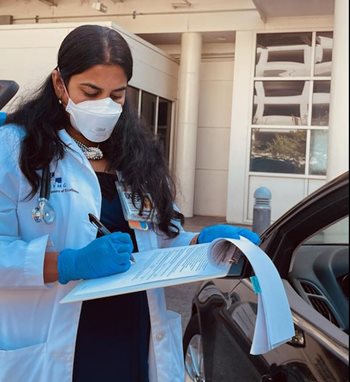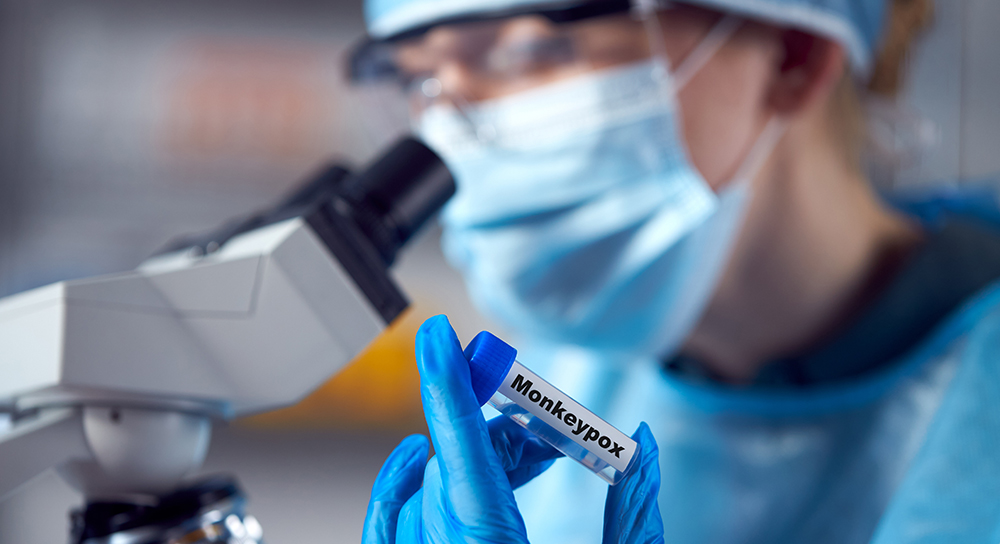Monkeypox — also called mpox or MPX — isn’t new. In fact, the first human case was identified in 1970 in the Democratic Republic of the Congo.
For decades, the virus was seen mainly in west and central Africa, but that’s all changing now. Mpox has recently resurfaced, spreading to 87 countries including the U.S. In August, the Biden administration declared monkeypox a public health emergency with more than 15,400 cases (as of August 22) and infections happening across the country.
Local spread of monkeypox
The first mpox cases in the Central Valley were reported in mid-July. Health officials around the country say the vaccine is the best preventative measure against contracting the virus, but there is a limited supply.
Locally, Dr. Geetha Sivasubramanian is leading the charge to vaccinate and treat patients at risk for mpox. Dr. Sivasubramanian is an assistant clinical professor of medicine and program director of the infectious diseases fellowship at UCSF Fresno. She and her colleagues have teamed up to provide Valley residents with access to treatment.
“Back in 2003, we had a large outbreak in the Midwest, and when I say large, it was about 47 patients, which was related to an imported animal,” said Dr. Sivasubramanian. “So what we're seeing this year is much different than what we've seen in previous years with monkeypox.”
How the virus is spreading
Unlike the animal-to-human transmission in the ‘70s, Dr. Sivasubramanian said the virus today is being spread from very prolonged close contact.
“But if someone has broken skin or if they have a cut, and that came in touch with an infectious material from someone with the virus … the infection could spread [to another person] at this point,” she said. “Prolonged close contact is what I would still be worried about with this infection.”
The World Health Organization (WHO) says human-to-human transmission happens through close contact with respiratory secretions, skin lesions of an infected person or recently contaminated objects.
Signs and symptoms
Dr. Sivasubramanian says the virus infection can be divided into two periods. The first period is incubation, which can range from 6 to 21 days according to the WHO.
“The virus needs prolonged close contact for infections to happen. If someone is incubating it, which happens the first one to two weeks, they cannot transmit the infection during the incubation period, so there's no need for quarantine,” she said.
In the second “infectious” period, skin eruption with blisters or pox marks usually begins within 1 to 3 days. Dr. Sivasubramanian said this is the time to quarantine as you can be contagious until the lesions are completely healed with new skin.
Monkeypox symptoms in humans usually start with a general, all-over feeling of being ill. Flu-like symptoms such as fever and muscle aches develop and lymph nodes become swollen.
A few days later, a blister-like rash appears that looks like chickenpox. This may begin on the face and spread elsewhere on the body or, if acquired during intimate or sexual contact, may begin around the genitals or anus.
The rash dries up a week or two later, and recovery continues.
Who's at risk?
People most at risk are:
Those who live with or have close contact (including sexual contact) with someone who has mpox.
Those who have regular contact with infected animals.
Newborn infants, young children and people with underlying immune deficiencies may be at risk of more serious symptoms and, in rare cases, death from mpox.
Health workers caring for mpox patients.
As of Aug. 19, there were 13 cases of mpox in Fresno County, according to Dr. Rais Vohra, interim health officer for the Fresno County Department of Public Health. Dr. Vohra said there is a limited vaccine supply, with only 730 vaccine doses allocated so far to the county. Already, 210 doses have been administered.
The county has plans to stretch the remaining supply, thereby increasing the doses per vial by changing the injection method. Since the allocations of vaccines are so limited, stretching the vaccine will give more patients access to the doses needed to prevent the infection.
Over the next few months, the county will also be adding more vaccination clinics to the four sites already dispensing the vaccine.
Steps to help prevent infection
Dr. Sivasubramanian said the vaccine is the best way to prevent infection, but additionally people should take every precaution to avoid infection, including:
Avoiding contact with animals that may carry the virus.
Avoiding close contact with people who have a skin rash that looks like mpox.
Avoiding handling clothes, sheets, blankets or other materials that have been in contact with an infected animal or person.
Isolating people or pets that have or have been exposed to mpox.
Washing your hands thoroughly with soap and water after contact with an infected person or animal.
 Is there a treatment for monkeypox?
Is there a treatment for monkeypox?
While there is no specific treatment for mpox, some at-risk patients are healing faster and having fewer complications with Tecovirimat (also known as TPOXX).
Dr. Sivasubramanian and her team with the UCSF Infectious Diseases department are one of the few providers in the Central Valley offering this treatment.
What to do if you think you have monkeypox
People with mpox who do not require hospitalization should follow CDC’s Isolation and Prevention Practices for People with Monkeypox.
If you suspect you’ve been exposed to mpox, call your doctor and isolate yourself from others.
For questions on the monkeypox vaccinations, call (559) 600-3550 or visit fcdph.org/monkeypox.


.jpg?language=en-US)


